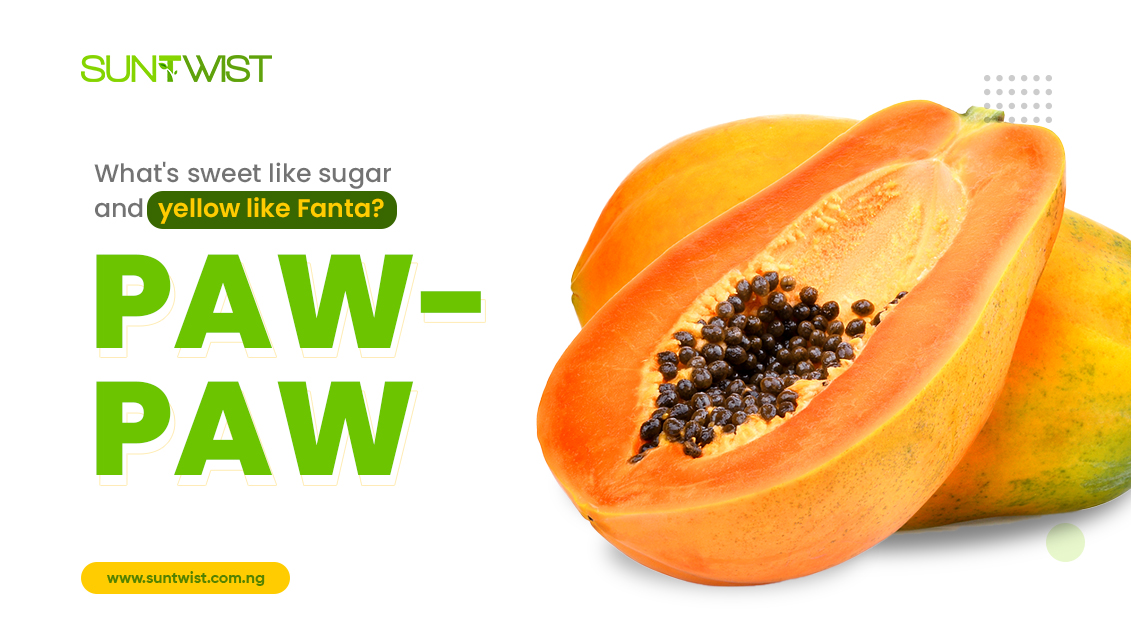CARICA PAPAYA
What’s sweet like sugar and yellow like Fanta?
PAWPAW
Back in the days, there’s a song about pawpaw we do sing. It goes like this…
Pawpaw is a kind of fruit
Sweet like sugar
Yellow like Fanta
Everybody likes Pawpaw
Pawpaw
Lol! It’s fun to bring back memories, at least most of us do know the song and must have sung it. Chai those sweet childhood days, we move…
You want to know some interesting things about Pawpaw then keep reading…
Pawpaw also called Papaya or Papaw is the fruit of the Carica Papaya tree, it is one of the 22 accepted species in the genus Carica of the plant family Caricaceae. The papaya is a. Mildly sweet, soft healthy tropical fruit and it is one of the most favorite fruit all the time due to its nutritional properties. Papaya is a native of southern Mexico and tropical regions of the Americas, it is a berry and grows from 5 to 10 meters (16 to 33 feet) tall. Papaya is a fast-growing tree and can best fruits within 6 to 12 months. They are flowering plants and every part of the tree has latex.
Papaya is a rich source of antioxidant nutrients such as Vitamin C, Vitamin B, carotenes, and flavonoids. They are also good sources of minerals and fibers such as Potassium, magnesium, and copper.
The black seeds of the papaya have a sharp and spicy taste, the seeds can be grounded and used as a substitute for black pepper. The papaya leaves have a proteolytic enzyme called PAPAIN which is also found in unripe green Papaya fruit. The proteolytic enzyme help break proteins down into smaller fragments called peptides and amino acids so, in a nutshell, the enzyme has the ability to digest protein. Papain can be used in the preparation of dietary supplements and chewing gum, Papaya is the only fruit that contains such enzyme.
Some fruits do have a day or month for celebration, well Papaya is not an exception. September is National Papaya Month.
There are two varieties of Papaya (Hawaiian and Mexican) that are sold throughout the world. The Hawaiian variety is the papaya commonly found in supermarkets. The flesh is orange or pinkish with black seeds at the center of the fruit. Mexican Papaya is larger than the Hawaiian type and the flesh is either yellow, pink, or orange. Ripe papaya fruit is a popular breakfast fruit or dessert and is usually eaten raw.
You may ask yourself what’s so special about papaya, everything about it is special. Papaya can be eaten as a smoothie, vegetable, or fruit in its raw form. The unripe green papaya is usually cooked either in curries, salads, or stews. Papaya also contains Beta-carotene which is converted to Vitamin A in the body.
Carica Papaya is rich in Vitamin A which helps protect your vision from degenerating, sometimes papaya is used in the treatment of Dengue fever. Papaya is popular in countries where it can be used as a treatment for burns, rashes, stings, and cuts. In some countries, the papaya leaves can be boiled and used in the treatment of some ailments. In some parts of the world, papaya leave tea is used in the treatment of malaria, but this has not been scientifically proven.
Carica Papayas are rich in fiber, vitamin C, and antioxidants that prevent cholesterol build-up in the arteries. It also helps to ease menstrual pain as funny as this sounds it is true, women who experience menstrual pain should eat some papaya because the enzyme present in it helps to regulate and ease flow during menstrual periods.
Did you know?
The largest papaya fruit was achieved by Confederacae de Agricultura e pecuaria on 28th July 2016, the fruit weighed 18,805.84 kg.
Papaya is ranked the fourth in tropical fruit production after bananas, oranges, and Mangoes.
Papaya was introduced in Hawaiian in the early 1800s and is the only state in the U.S that grows papaya commercially.
Christopher Columbus called Papaya the “Fruit of Angels”.
Just one small papaya has more than 300-percent of the recommended daily allowance (RDA) of vitamin C.
You may not include this fruit in your grocery list but you just have to get it for yourself and your family.

